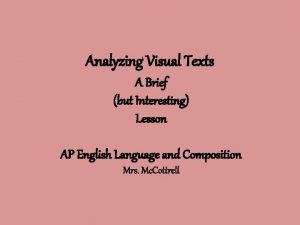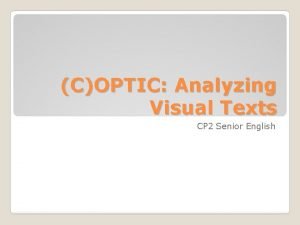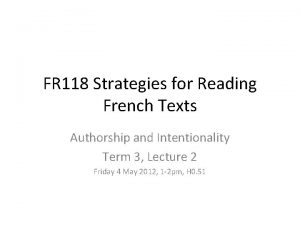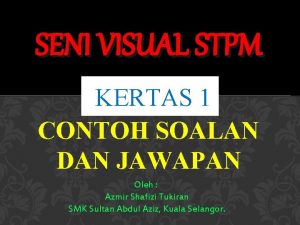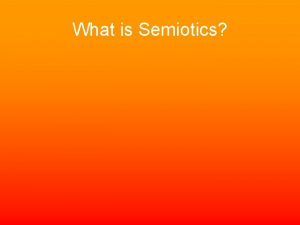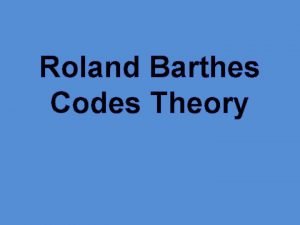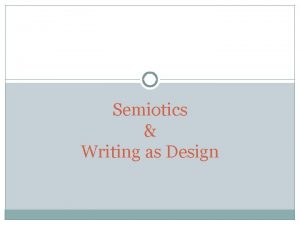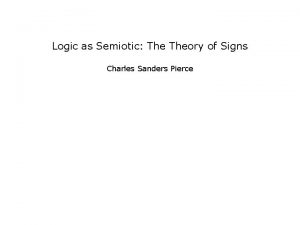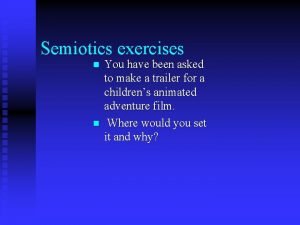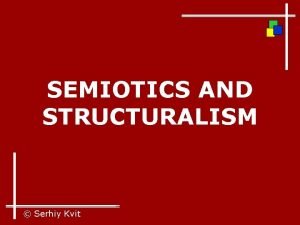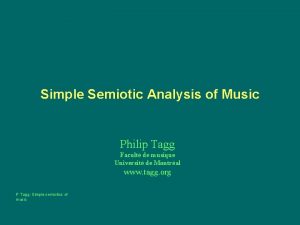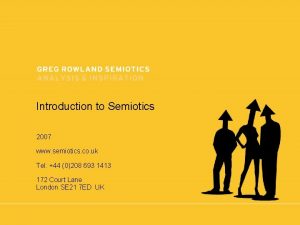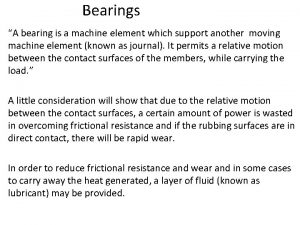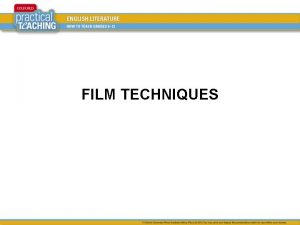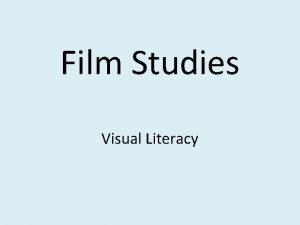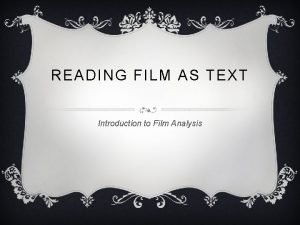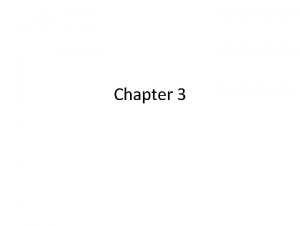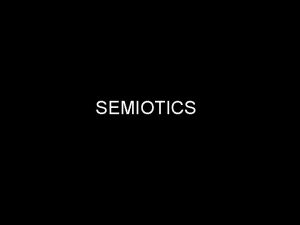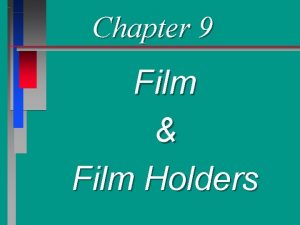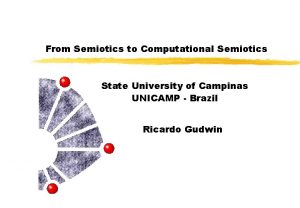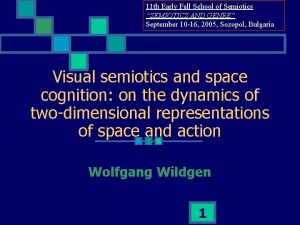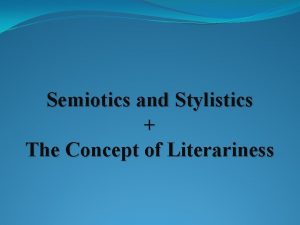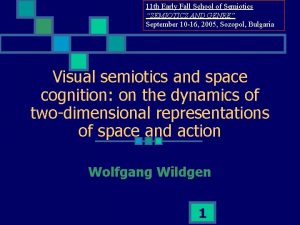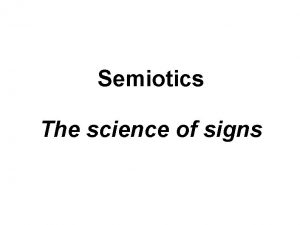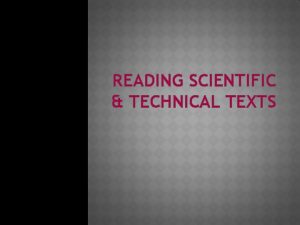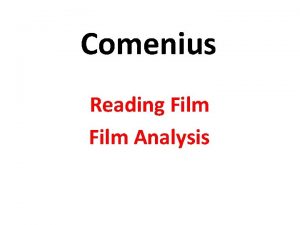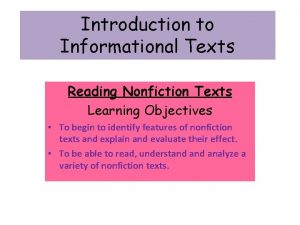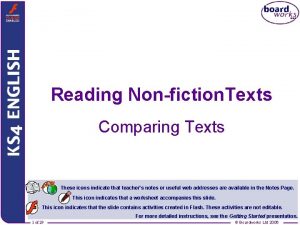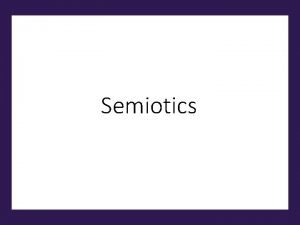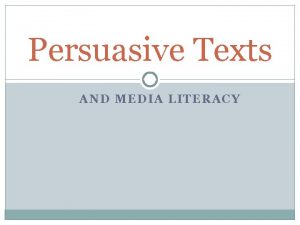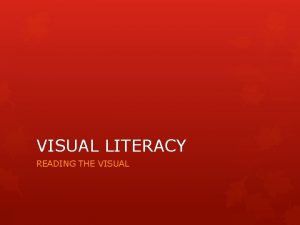Media Semiotics Reading Visual Texts Part 2 Film

























- Slides: 25

Media Semiotics: “Reading” Visual Texts, Part 2. Film Language Michael Fitzgerald HU-3000 Winter, 2009

Film “language” • Film does not literally have a “language” (we are using the word as a metaphor or comparison). • There is no basic linguistic unit, such as a word. • There is no formal grammar. • Film does, however, make statements, so it works like a language. • The closest devices it has to a real language are: – shots (could be compared to words) – scenes (like sentences) – sequences (like paragraphs) • However, these are often difficult to differentiate from one another: • A lengthy shot can be considered a scene. • Statements can be made within a shot, using movement, focus, color, proxemics, camera position, etc. ).

Two types of film “statements”: Paradigmatic and syntagmatic • Paradigmatic: Everything that is seen in the shot (miseen-scene) including how it is composed: – what to shoot – how to shoot it Usually associated with realism. • Syntagmatic (contextual)—usually associated with expressionism: – editing/“montage”

Paradigmatic statements • • • Mise-en-scene: everything in the shot, including how it is composed Staging, sets, props, costumes, casting, etc. Use of frame • Closed • Open Proxemics /proximity (distance from camera) – ECU – MS (“two-shot”) – LS – ELS Proxemics /“blocking”: use of space, placement of actors, etc. Composition – lines (vertical; horizontal; diagonal or oblique) – lighting source/direction – camera angle/Po. V • tilt (low/high; up/down): look for horizon • roll (slant) • crane (extremely high) • overhead/”bird’s-eye view “(often with see-through ceiling) • helicopter (ELS): God’s-eye view

More paradigmatic statements • • • Choice of film: – Low or hi-rez (70 mm, 35 mm, 16 mm or Super-8; videotape). Low rez (grainy) suggests immediacy and actuality. Lighting: – Available (“magic hour”) or artificial. – bright or dark (noir). – key, fill, back, etc. – silhouette (back light only). Colors: – warmth, coolness, danger, passion, etc. – color intensity (saturation). Focus: – sharp – soft (sometimes done with filters or screens) – planar (rack shot/rack focus): can alternate between two planes – deep focus (dev. by Gregg Toland; see Citizen Kane) – zoom in or out (what does zoom-in to ECU of face imply? ) Camera movement: – track shot, dolly shot, truck shot, crane (or motorized Louma) shot, sky-cam – hand-held (shaky). Documentary style: suggests immediacy, actuality, action

Composition (deep focus)

Synecdoche

Rack focus

Rack focus

Close-ups • Camera angles, close-ups, and editing techniques contribute to viewers’ feelings toward a character. • Viewers do not care much either way about characters seen at a distance. • They are more likely to empathize or identify with a character who is often seen in close-ups. Meyrovitz, Joshua. “Multiple Media Literacies. ” Journal of Communications 48 (1). Winter 1998: 96 -108.

ECU

ELS

ELS as “establishing shot”

Low-angle shot

Aura (halo effect)

Aura (halo effect)

Aura (halo effect)

Syntagmatic statements • Two images juxtaposed suggest a third meaning:

Montage (Fr. : “mounting” or “assembling” • In US called cutting or editing (taking away) • Logical purpose is to collapse time (fast-forward), skip mundane details (“cut to the chase”), eliminate dead air, etc. • Occurs in: – storytelling, jokes, etc. – novels (“meanwhile, back at the ranch…”) – dreams (jump cuts)

Two basic concepts of montage: Diachronic (chronological or linear): • One idea leads chronologically to the next: • shot/reaction shot • dissolve to next scene • match cut • One idea leads logically (in terms of how the story is being told) to the next: • Flashback/flash-forward • What about Memento? Synchronic (non-linear): • Two or more things appear to happen simultaneously: • Parallel editing (“cross-cutting”): two scenes occurring at the same time (chase scene) • Two separate story lines that converge later (or maybe never—used often in serials) • Scenes/shots may have no logical relationship but are juxtaposed strictly for emotional effect: • Sergei Eisenstein (Soviet filmmaker) • Ox-slaughtering images in Apocalypse Now • Can be used to connote fast action or excitement • Often used in TV commercials and music videos to hold viewer interest— simply because movement in itself is compelling

Realist fiction Borrows from documentary/actuality – location shoots – hand-held camera technique – grainy film – available lighting – long takes, minimal editing – edits are usually linear, chronological – nonprofessional actors Ex. : Lumiere brothers, Workers Leaving the Lumiere Factory (1895).

Expressionism – dream-like, fantastical, mythical – montage/jump cuts – non-linear editing – shot on sets – staged lighting – viewers expected to “fill in” their own meanings Ex. : Georges Melies, Trip to the Moon (1902) Robt. Wiene, Cabinet of Dr. Caligari (1920)

Classical Hollywood style • • • well-known actors heavy on glamour, myth, fantasy careful lighting (three-source) carefully controlled sound careful, often elaborate camera work (Steadicam, tracks shots, cranes, helicopters, etc. ) high-resolution film smooth, precise (“invisible”) editing usually linear, mostly chronological does most of the “work” for viewers

Classical Hollywood style • Where does classical Hollywood drama fall in the realism-expressionism continuum? – actuality (no editing, Lumiere Bros. ) – verite/direct cinema (stark documentary style, minimal editing, minimal or no story line—“slice of life”) – narrative documentary style – realist fiction – classical (Hollywood) – expressionist (Melies, Weine, etc. ) – experimental (Dziga Vertov)

Quotes “Everything about a movie is manipulation. ” –Frederick Wiseman, documentary filmmaker “I enjoy playing the audience like a piano. ” – Alfred Hitchcock
 Analyzing visual texts
Analyzing visual texts Analyzing visual texts
Analyzing visual texts While reading activities
While reading activities Mentor texts for reading workshop
Mentor texts for reading workshop French texts for reading
French texts for reading Reka bentuk grafik merupakan salah satu bidang seni halus
Reka bentuk grafik merupakan salah satu bidang seni halus Peirce semiotics
Peirce semiotics Proairetic
Proairetic Semiotics myth
Semiotics myth Semiotics
Semiotics Semiotics
Semiotics Semiotics
Semiotics Semiotics
Semiotics Connotation of shark
Connotation of shark Semiotics
Semiotics Semiotics in music
Semiotics in music Greg rowland semiotics
Greg rowland semiotics Slipper or guide bearing
Slipper or guide bearing Camera shots
Camera shots Visual literacy in film
Visual literacy in film Is film a text
Is film a text Apakah maksud visual pada kata pemrograman visual ?
Apakah maksud visual pada kata pemrograman visual ? Seeing as reading meaning
Seeing as reading meaning Part whole model subtraction
Part whole model subtraction Part to part ratio definition
Part to part ratio definition Brainpop ratios
Brainpop ratios
